Japan, Take 2
My Rainbow is the rainbow of the Kabuki curtain~
Due to the ridiculously annoying layout system of this site (I'm editing this according to the layout I'm shown as the "final print product" I will eventually order off this site, so apologies for how it turns out online in the meantime), I can't start this chapter with a photo, so it will follow.
April 15-19 虹始見 The First Rainbow Appears
April 17, 2018
|
Osaka
My Rainbow is the rainbow of the Kabuki curtain~
Due to the ridiculously annoying layout system of this site (I'm editing this according to the layout I'm shown as the "final print product" I will eventually order off this site, so apologies for how it turns out online in the meantime), I can't start this chapter with a photo, so it will follow.
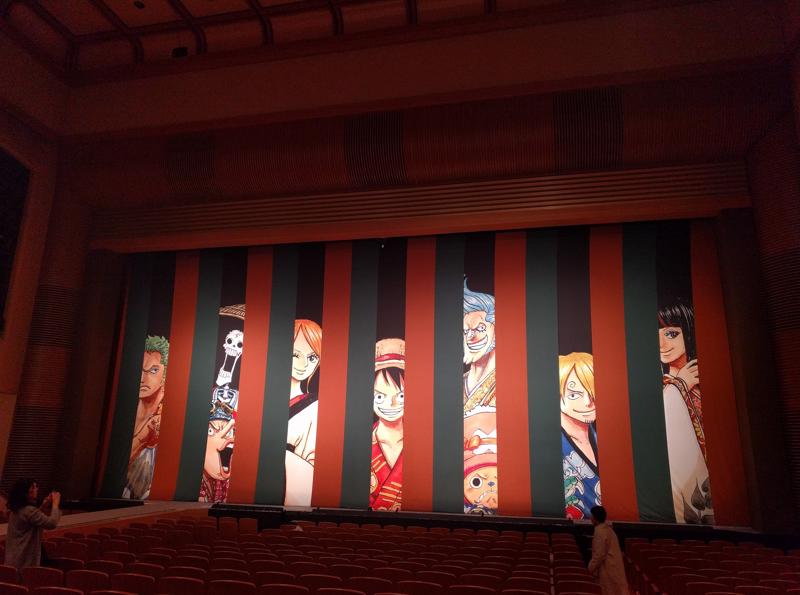
I can't blame this all on Nick, since I have been slowly trying to get out of my rut and back into actively DOING things, but after spending the week with him and Geoff, I have ramped up my live theatre viewing schedule to something that I will not be able to sustain if I am not allowed to get income from a part-time job (or get secondary funding). I guess it's a good thing I endured living at home for 3 years so I could have emergency savings.
Ok, no more whining. Let's talk Super Kabuki.
I remember reading about Super Kabuki when I took my courses on Japanese theatre. Quick rundown of the history of Kabuki for those of you who don't know:
One of Japan's traditional theatrical arts, Kabuki is a form of theatre where all the roles are played by men, the actors are under a heavy layer of white (or beige) makeup, and the shows are all repertoire, i.e. all the Kabuki plays one can see performed were all written during the heyday of Kabuki, and new material is just not written. Kabuki is known for its adherence to its tradition, be it keeping its codified movements, still following the passing down of famous stage names within the family of actors, or it still not allowing females on their stage. Young Japanese people usually have little interest in Kabuki, especially the generation that grew up with heavy Western media influence. It's viewed as an antiquated thing, and I have met many Japanese students who have never seen a live performance before, and are shocked that I, a foreigner, has both seen live performances and am interested in the form.
That said, a number of years ago, one of the biggest names in Kabuki actors, Ichikawa Ennosuke débuted something called "Super Kabuki", in attempt to refresh the genre and reignite interest in the younger generation. Using wires, recorded audio, live water on stage, and incorporating a number of more modern stage craft, Super Kabuki was made to be a spectacle to be experienced. It's been a while since I read about Super Kabuki, and I don't have access to my old texts right now, so that's about as much as I want to summarize, lest I accidentally give terribly false information.
I was not planning on seeing the One Piece Super Kabuki. I know very little about the Intellectual Property of One Piece and wasn't all that interested in trying to catch up on its 800+ chapters of content. However, after seeing the live 3-school Okina with Nick and Geoff, and being blown away by how an updated traditional show could look, I decided to take the plunge and get a ticket to see the Super Kabuki. After all, I'm currently in Japan, and if I wanted to see it later
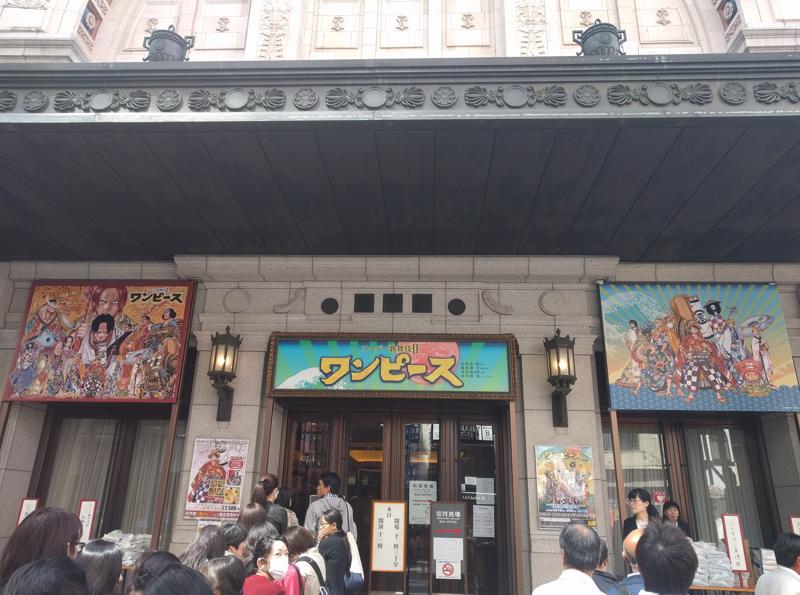
on in life, I'd have to factor in the cost of the flight and accommodations, and that's just not economical.
So I ordered a ticket online, as I was able to find a weekday matinée show which still had cheap seat tickets available. My seat was in the balcony, and as soon as the show started, I realized what a disservice I had done myself by being cheap. I had no view of the Hanamichi (important stage right gangplank-like walkway that runs into and past the audience in Kabuki theatre, where many entrances and exits are made. ha pun~), and could hear all the action I was missing out on.
Now I'm going to consult my notes and give as much of a theatrical analysis as I can with my MFA background.
Stage
The venue was the Shochiku-Za in Osaka, and from my moderately-trained eye, it does not look like a traditional wide Kabuki stage. They used the entire depth of the stage, which is highly uncommon for Kabuki. There were no painted backdrops, only projected backgrounds against the back of the stage, or moving panels and flys. The stage floor itself was also black, which made the glo-tape stand out nice and clear during blackouts from my vantage point in the balcony. This stage had a Mawaributai (rotating central
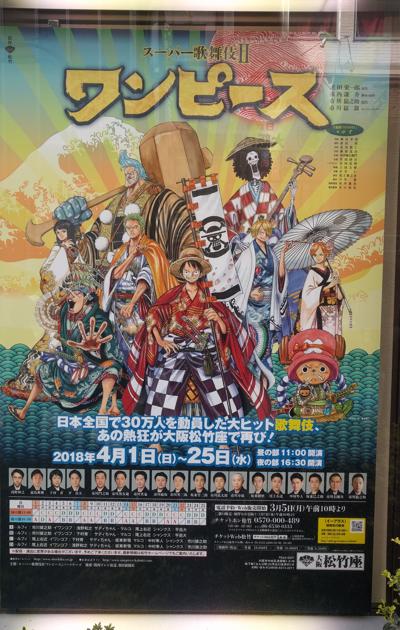
stage), and it was used to great effect in changing the acting area and dramatic reveals. The Mawaributai is something found in a lot of Japanese theatres as a way of quickly changing the stage set, as you could build two sets on the same stage, back to back, and just turn the stage 180º to switch from one to the other.
In the 2nd part of the play, the stage was turned at such an angle so that the walkway between the front set and back set created a thoroughfare from upstage left to the downstage right hanamichi, essentially creating an extremely long running path that was the hypothenuse of the stage plus the length of the hanamichi. And since the two sets were both jail compartments with bars, there weren't solid walls to block the view of the audience.
In the 3rd part of the play, the mawaributai was used to dramatically reveal a whole set of other characters, as the trap doors slowly rose and elevated while the stage was turning. The slow turning created
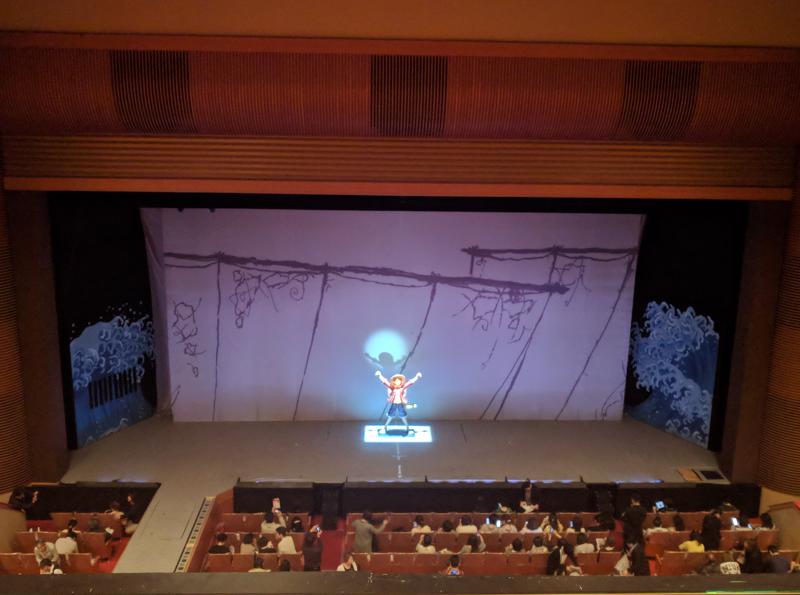
much anticipation in the audience, and the final ki-clack when the stage finally stopped well above eye level and the characters made their mie poses was extremely satisfying.
I found the use of the full depth of the stage to be odd, but due to the sheer size of the cast of characters, and the number of staged combats, it made sense to give that much space to 20+ actors on stage all doing physical "fights".
Traditional Kabuki
This was what I had wanted to see: how they used the traditional codified Kabuki movements and instruments to tell the story of a Pirate manga/anime. For most of the production, there was a ki player sitting at the corner of the proscenium downstage left, with his wooden ki and his wooden board. There were still drums hidden behind vented screens downstage right, and they did indeed play the traditional rolling drum sounds of the waves when the story took the characters to sea.
The stage combat was mostly tachimawari, the stylized non-contact stage fighting in Kabuki, which worked really well with the main character, a Pirate who has the physical constitution of ... stretchy rubber? (and that was truly the extent of my knowledge of One Piece prior to seeing the show: the main protagonist is called Luffy, and he is a pirate. He is stretchy a la Gumby/Stretch Armstrong. He has a merry band of pirate companions on his pirate ship and they have pirate adventures. I found out in the opening introduction of the show that his life's goal is to find the legendary piece of gold called the "one piece", and there you have the title.) Because his character quirk is his ability to stretch, the use of tachimawari kata was surprisingly effective, as the lack of actual physical contact would evoke the mental conjuration that he had stretched his limbs in combat.
In a song and dance routine, Luffy's stretching ability was shown by having 4 stagehands (oh, this is punny) dressed all in black, except for their arms, stand to his sides, and the actor and stage "hands" linked arms together, to "lengthen" Luffy's arms. (traditionally, Japanese stage hands are dressed all in black, covering as much of the body as possible, as a codified way of indicating that they are "invisible" to the audience. This convention is also used in the puppet theatre, and have been used to great effect in some special effects scenes, many of which can be viewed online. There was a well-known clip a number of years ago of a Ping-pong sketch which utilized the black stagehands.) In some ways this was traditional, but in some ways this was also a modern technique? I am on the fence on this one.
Since Kabuki is also well known for its quick changes onstage to showcase the brilliance of its main actors, there were a few scenes where the actor playing Luffy would converse with himself, as the actor quickly transformed into a Queen-like ruler character behind a small set piece. This convention obviously employs a body double, but it also meant (much to my western acting chagrin) that the actor spoke upstage to hide his face until the reveal that he had magically switched characters. This back-and-forth onstage quick change was fascinating to see in action.
Modern Theatre
I found out after the fact that this production did not limit its actors to only Kabuki performers. There were also actors from TV/Film who were a part of the cast, and in hindsight I see exactly which of the performers had a Kabuki background. This also explained why the 2nd part of the show included what I can only describe as an 80s acid trip fever dream of neon and disco-ball crotches, complete with a sparkly purple Dr. Frank-N-Furter. He was a TV personality. This portion of the show resembled a concert more than live theatre, and it took me out of the experience a little.
Projections were not used sparingly, and everything from blood, battle, poses, waves of water, to house projections were employed for audience immersion. I particularly enjoyed the projection of waves on top of painted waves to simulate movement of water.
One of the most reminisced about points of the Yoshitsune Senbon Sakura Super Kabuki was the flying in of the Fox character from wires. Unsurprisingly, flying wires were also used in One Piece Super Kabuki. The first was the exit of Luffy from stage, as he "rode the waves" (he has a mini surfboard bound to his feet), and was lifted up from the 7-3 spot on the hanamichi up to the balcony, where a temporary black curtained room was set up. This was also the portion of the show where the musical collaboration theme song was played, and audience participation was encouraged in the form of the playing of tambourines (on sale before the show).
The second use of the wires through the audience was an entrance of
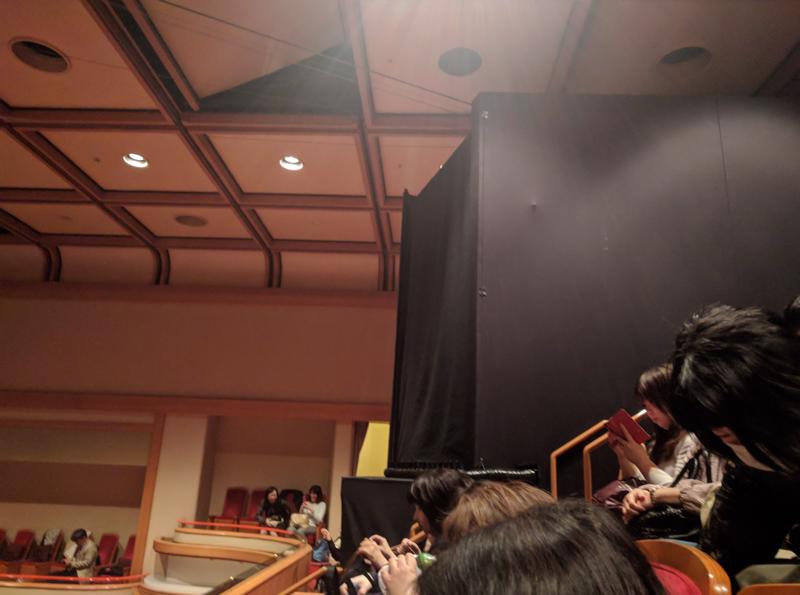
another character, this time entering from the balcony, and he did forward flips and backflips in the air before landing on the 7-3 again to officially enter the stage.
The use of a different set of wires happened in the 3rd portion, where yet another character ran in an arc from downstage left, to upstage, then to downstage right, and then continued his trajectory into a circle above the audience. This was accompanied by paper confetti flying in the house, and such was the fan system used that I even had confetti land on me in my balcony seat, which is an impressive feat.
Water
This was something truly unique in its execution. The waterfall battle scene closed the 2nd Act, which was surprising to me, as that meant the stagehands would have to do a very good job drying the stage in the 30min 2nd intermission before the final act. Courtesy ponchos were handed out to the audience members in the front rows at the top of the 2nd Act, and boy did they need them. Not only were the actors splashing during the fight on the waterfall wall and in the pool directly below, but the ensemble actors used the wet fore stage as a slip-n-slide, and purposefully splashed water into the audience.
Costumes
It was only during my second viewing that I was able to notice more of the costume details, as my seat was also on the main floor (and 3x the price). Luffy had no less than 5 iterations of his iconic red vest-blue jean shorts look, with various other costume changes (upon being poisoned? and shipwrecked) according to story material.
One thing I found interesting to note was the use of female body suits. Of course the silhouette of the female kimono is a column, and much effort is put into padding out the body appropriately to achieve that flat-chested look for curvier women when donning kimono. This aesthetic is very favourable for the male kabuki actors when performing traditional pieces, but apparently the well-endowed females in the One Piece manga demanded a slight change. The actors portraying the more scantily clad female characters wore noticeable female body suits, especially the character of Sadi, who wore a fishnet body suit costume, on top of obvious breast padding.
I also appreciated the incorporation of traditional Kimono silhouettes for the sake of Kabuki, when the source material arguably takes its clothing from modern styles. One particular character (Tsuru) wore an open kimono instead of an open military coat, and held the collar ends to walk, exactly as a noblewoman character would in traditional kimono.
Speech
Sadly, my Japanese language skills were not strong enough for me to understand all the dialogue. However, I was able to pick out certain Kabuki kata in some of the speeches. One notable exchange happened in the Jail scene, where two characters utilized the well-known passing back-and-forth of lines (the term for this escapes me at the moment).
Another line I recognized from stylized Kabuki speech was "Kokoroemashita". That form of speech is incredibly indicative of Kabuki, and I have not heard it uttered outside of Kabuki theatre.
Chinese Theatre (Jingju) influence?
In the 3rd Act of the play, a battle took place in a place filled with fire. Ensemble characters came onstage with large fabric flags, and waved them to simulate fire. This particular scene made an impression on me due to its similarity to the water flag choreography I learned when we performed "White Snake" at the University of Hawaii. Granted, I am well aware that there is limited choreography available for dual-wielding 1mx1m fabric flags, but I cannot help to wonder if the fight choreographer took any influence from the well-known Chinese Jingju piece.
And that is a very fragmented regurgitation of my experience and thoughts on the One Piece Super Kabuki. The next leg of their tour is happening in Nagoya, for the month of May. I highly recommend seeing this, even if the tickets feel ungodly expensive. It is an innovative way of introducing a younger audience to a traditional theatrical art of Japan that was designed to stagnate. I am truly grateful to Ichikawa Ennosuke (the first?) for finding a way to revive this slowly dying form, and for the current Ichikawa Ennosuke for incorporating popular IP into this fantastical world.
1.
Foreword
2.
72 Seasons of Japan: 雪下出麦 Beneath the Snow the Wheat Sprouts (January 1-5)
3.
Pheasants are like peacocks, right? 雉始雊 The Pheasant's First Calls (January 16-20)
4.
January 21-24 款冬華 The Butterbur flowers
5.
January 25-29 水沢腹堅 Mountain Streams Freeze
6.
January 30-February 3 鶏始乳 The Hens start laying eggs
7.
February 4-8 東風解凍 Spring winds thaw the ice
8.
February 9-13 黄鶯睍睆 The Nightingale Sings
9.
February 14-18 魚上氷 Fish Rise from the Ice
10.
February 19-23 土脉潤起 The Earth becomes Damp
11.
February 24-28 霞始靆 Haze First Covers the Sky
12.
March 1–5 草木萌動 Plants Show First Buds
13.
March 6–10 蟄虫啓戸 Hibernating Creatures Open their Doors
14.
March 11–15 桃始笑 The First Peach Blossoms
15.
March 16–20 菜虫化蝶 Leaf Insects become Butterflies
16.
March 21-25 雀始巣 The Sparrow Builds her Nest
17.
March 26-30 櫻始開 The First Cherry Blossoms
18.
March 31-April 4 雷乃発声 Thunder Raises its Voice
19.
April 5-9 玄鳥至 The Swallows Arrive
20.
April 10-14 鴻雁北 Geese Fly North
21.
April 15-19 虹始見 The First Rainbow Appears
22.
April 20-24 葭始生 The First Reeds Grow
23.
April 25-29 霜止出苗 The Frost Stops; The Rice Grows
24.
April 30- May 4 牡丹華 The Tree Peony Flowers
25.
May 5-9 蛙始鳴 The First Frogs Call
26.
May 10-14 蚯蚓出 The Earth Worms Rise
27.
May 15-20 竹笋生 Bamboo Shoots Appear
28.
May 21-25 蚕起食桑 The Silk Worm Awakes and Eats the Mulberry
29.
May 26-30 紅花栄 The Safflower Blossoms
30.
May 31-June 5 麦秋至 The Time for Wheat
31.
June 5 - June 9 蟷螂生 The Praying Mantis Hatches
32.
June 10 - 15 腐草為螢 Fireflies rise from the Rotten Grass
33.
June 16 - 20 梅子黄 The Plums turn Yellow
34.
June 21 - June 25 乃東枯 The common Self-Heal Dries (Summer Solstice)
35.
June 26 - June 30 菖蒲華 The Iris Flowers
36.
July 1 - July 6 半夏生 The Crow-dipper Sprouts
37.
July 7 - July 11 温風至 Hot Winds Blow
38.
July 12 - July 16 蓮始開 The First Lotus Blossoms
39.
July 17 - July 21 鷹乃学習 The Young Hawk Learns to Fly
40.
July 22 - July 27 桐始結花 The First Paulownia Fruit Ripen
41.
July 28 - Aug 1 土潤溽暑 Damp Earth Humid Heat (Major Heat)
42.
Aug 2 - Aug 6 大雨時行 Heavy Rain Showers
43.
Aug 7 - Aug 11 涼風至 A cool Wind blows (First Autumn)
44.
Aug 12 - Aug 16 寒蝉鳴 The Evening Cicada Sings
45.
Aug 17 - Aug 22 蒙霧升降 Thick Fog Blankets the Sky
46.
Aug 23 - Aug 27 綿柎開 The Cotton Lint Opens (Limit of Heat)
47.
Aug 28 - Sept 1 天地始粛 Earth & Sky Begin to Cool
48.
Sept 2 - Sept 6 禾乃登 The Rice Ripens
49.
Sept 7 - Sept 11 草露白 Dew Glistens White on Grass
50.
Sept 12 - Sept 16 鶺鴒鳴 Wagtails Sing
51.
Sept 17 - Sept 21 玄鳥去 Swallows Leave
52.
Sept 22 - Sept 27 雷乃収声 Thunder Ceases (Autumn Equinox)
53.
Sept 28 - Oct 2 蟄虫坏戸 Insects hole up Underground
54.
Oct 3 - Oct 7 水始涸 Farmers Drain Fields
55.
Oct 8 - Oct 12 鴻雁来 The Geese Arrive
56.
November 19
Share your travel adventures like this!
Create your own travel blog in one step
Share with friends and family to follow your journey
Easy set up, no technical knowledge needed and unlimited storage!